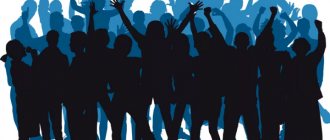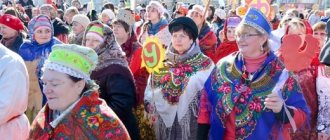A crowd is a chaotic, but still not devoid of a certain organization, large gathering of people. Most often it arises due to the fact that some circumstances, events, incidents, etc. attract mass attention. However, this is not the only thing that unites people in the crowd, because... The general mental state, tension, emotions, motives and other features come into force.
All this, including the behavioral reactions of social groups and individuals within them, is studied in a separate direction - crowd psychology. This article is dedicated specifically to her. We will try to consider the psychology of the crowd briefly, but as objectively as possible.
Crowd: definition and nature of its formation
For the first time, the famous French sociologist Gustave Le Bon tried to give a scientific explanation of the crowd phenomenon at the turn of the 19th and 20th centuries. His first articles on this topic were published in Revue Scientific in 1885, and then his book “The Psychology of Crowds” was published, after which the ideas began to gain popularity in scientific circles. The very problem of studying the crowd has become the object of attention of many scientists, including domestic ones (V. M. Bekhterev, G. M. Andreeva and others).
The concept of “crowd,” by the way, became part of social psychology when mass revolutionary unrest occurred in the world (again, this is the turn of the 19th and 20th centuries). For this reason, at first the crowd was understood as poorly organized protests of the proletariat against the ruling class.
Currently, psychology interprets the term “crowd” as follows: a crowd is an unstructured and unorganized collection of people united by a single object of attention and the same feelings regarding it. One of the hallmarks of a crowd is the absence (or loss) of a conscious and clear common goal.
A classic example of a crowd in social psychology is a crowd of people during any transport accidents, mass events, pickets, protests, rallies, natural disasters, military exercises, etc.
Surely you yourself have been a member of a crowd or observed this phenomenon at least once in your life. Actually, it is simply impossible to ignore the so-called crowd effect, because people who find themselves in a crowd almost instantly convey its mood and behavioral reactions. They join this mass and become part of it, even if this goes against their own principles and desires.
The behavior of a crowd can be very unpredictable, and its mood can pose a potential threat to individuals and society as a whole, as well as to the infrastructure of populated areas (organizations, buildings, cultural objects, etc.) By the nature of the formation of a crowd, it can be quite easily determined compound. Typically the crowd consists of:
- Instigators . This is the core of the crowd. It is made up of people who form it, competently and correctly configure it and use it for specific purposes.
- Participants . These are people who have joined the crowd and take an active part in its actions. Easily suggestible and sympathetic people (with a heightened sense of justice), ordinary people and people who do not have a specific goal for their current actions can be influenced by the crowd. Let us note that the latter category often contributes to the creation of mass participation, but does not take active part in the activities of the crowd. The most dangerous participants are people who use the crowd to splash out negative energy, anger, and aggression.
Gustave Le Bon's research made enormous contributions to crowd psychology. It is largely thanks to them that this scientific direction today identifies two main mechanisms of its formation. The first is the growing emotional contagion, and the second is rumors. The process of crowd formation itself occurs in several stages:
- Formation of the core of the crowd . Despite the fact that a crowd arises spontaneously, its formation is impossible without a core. Such a core may be instigators who are aware of their actions and pursuing specific goals, or some event (incident). Then banal curiosity begins to act, attracting even more people to the center. Interest leads to the fact that people join the crowd, and there can be any number of such “infusions”, and each of them fuels emotions, which is why people are attracted again and again.
- Whirling . When a crowd has formed, tension begins to accumulate within it, which is why people’s perception of any external influences intensifies. A circular reaction occurs and the excitement becomes stronger. This leads to the fact that the entire mass of people is ready to react with lightning speed to incoming information.
- The emergence of a new object of attention . The processes occurring within the crowd (gossip, gossip, conversations fueled by the intensity of feelings) change the reason that served as the source of the crowd, i.e. core. The image created by the people themselves from the crowd comes into play. Everyone accepts it, and therefore it captures people’s attention and feelings, and also sets the direction for further actions.
- Activating individuals . As one might expect, the tension accumulated within the crowd requires release. It is achieved through additional stimulation of crowd participants. To do this, their imagination is fueled and suggestion is made. The result is certain actions of people, and they may well defy logic and be unsafe. The instigators or a specific leader add fuel to the fire. In this way they strive to achieve their goal.
It is important to note that an already formed crowd can be very dangerous, especially if it is controlled (and contained within) by aggressive people. The consequences of the actions of such a crowd can be the most destructive. It is extremely difficult to curb an uncontrollable crowd. But let's not exaggerate, but watch a short video about how the behavior of even a small number of people can affect the behavior of one person.
Occasional type
In this case, the name also determines the characteristics of the crowd. The word "occasion" from English means "accident". That is, an occasional crowd is a gathering of people who have gathered to watch an unexpected incident. An absolutely ordinary situation from the social sphere, which each of us has witnessed at least once in our lives.
If a UFO lands on the square of a city, then probably in about 15 minutes there will be no crowd to get through to it. A whole cloud of onlookers will instantly form around him. What are they? These are separate individuals who, by chance, find themselves connected by one center of attention.
How quickly a crowd forms, as well as its size, depends on the informational value and unusualness of the incident. Let's say a kitten is stuck in a tree - it is unlikely that at least a hundred people will gather to watch how they will get it out of there. What if suddenly someone puts a suitcase with a million rubles in the middle of the street and says that in 10 minutes he will give it to the person he likes the most? People will probably run away from work for this.
Crowd types
After we have briefly examined the main characteristics of a crowd and the features of its formation, it’s time to talk about what types of crowds exist. The psychology of masses cannot be considered as something unchanging, and further you will understand why. The crowd can be divided into types according to various criteria.
The first sign is controllability, and the crowd may be:
- Spontaneous - when its formation and manifestations occur on their own and no one controls it.
- Followed - when it is formed and directed by a specific leader.
The second sign of a crowd is behavioral reactions, and a crowd can be:
- Occasional - its basis is interest in some reason (event, incident) that arose spontaneously. Such a reason could be a fight, an emergency, a fire, etc.
- Conventional - formed due to interest in any mass event (concert, sports match, etc.) Such events are usually planned in advance, announced, advertised and expected by people. A conventional crowd can be controlled because... it operates within the given regulations. But control is always temporary, and the regulations themselves do not have clear boundaries.
- Expressive - where people unite due to the same attitude towards events or incidents (rejoice, condemn, protest, indignant, etc.) This type can also include an ecstatic crowd, the excitement of the participants is transformed into ecstasy. Such crowds can be observed at concerts, carnivals, and during religious events that plunge people into euphoria.
- Acting - formed through emotional unity. This type of crowd is either already taking specific actions or preparing for them.
The active crowd, in turn, can also be divided into several types:
- Acquisitive - participants are united by the struggle for material values, such as goods, money, food, seats in public places, etc. This type of crowd can form during discount promotions, new products going on sale, product shortages, rush hours, bankruptcy of financial institutions, natural disasters, catastrophes and terrorist attacks.
- Panic - participants are united by mass panic, motivating them to escape from danger. People's panic can be associated either with a real (evacuation notice, etc.) or with an imaginary (rumors of a terrorist attack, etc.) threat.
- Aggressive - participants are united by aggression directed at a specific object. Thus, people can hate a specific person, a race of people, a subculture, a social movement, a structure, etc.
- Insurgent - participants are united by dissatisfaction and indignation with the work of state structures and the government. Such crowds often become a powerful weapon in political struggle.
The variability of the crowd determines its characteristics such as instability of structure, presence, absence and clarity of goals. Therefore, one type of crowd (as well as a subtype) can easily turn into another. So crowd control (including crowd decontamination) requires an accurate understanding of the intricacies of crowd formation and behavior. For the same purposes, as well as for general development and your own safety, you also need to know the psychological properties of the crowd, which will be discussed later in the article.
Aggressive type
This type of crowd needs to be discussed separately. In an aggressive crowd, the level of emotional arousal, as well as external and internal activity, constantly increases. Mental stress gradually manifests itself, which is based on feelings of anger, despair, frustration, and misunderstanding. The crowd moves from an active state to an aggressive one due to the appearance of a so-called exciting stimulus. It is he who provokes the emergence of general indignation and indignation.
But the main thing that distinguishes an aggressive crowd is its destructive behavior. Crowds of people who are united by a feeling of fear, which is usually caused by danger to life, are divided into panic and those fleeing. Their behavior becomes destructive - the level of awareness of the actions being performed falls, the critical attitude to the situation disappears, and the experience of fear becomes more acute.
And panicked crowds are more dangerous than those fleeing. Because their behavior poses a greater threat to people. In a panicked crowd, the organization is completely lost, and its participants begin to behave unconsciously, mechanically, and inappropriately. They are completely consumed by fear. A fleeing crowd, which is more predictable, can be subordinated to the organization, since its participants retain the ability to regulate their behavior and be aware of what is happening for some time.
Psychological properties of the crowd
The psychology of the masses is explained by a whole complex of features that are characteristic of large crowds of people. These features relate to the most important areas of a person’s personality: cognitive, moral, emotional-volitional and temperamental. Let's look at them briefly.
In the cognitive sphere we can distinguish the following properties:
- Infectivity and suggestibility. People in a crowd easily pick up on the general mood and are overly susceptible to suggestion. It is extremely easy to introduce a certain idea or image into their consciousness.
- Lack of awareness. Reason and logic are completely alien to the crowd. She is ruled by emotions. Even in ordinary life, people do not always think rationally, let alone situations when they succumb to the herd instinct. In a crowd, the unconscious begins to dominate the conscious.
- Imaginative thinking. In large and spontaneous crowds, people think figuratively - their thinking is extremely simplified. Because of this, subjective information ceases to differ from objective information, people do not perceive complex ideas, lose the ability to reason, discuss, delve into details and make choices. It turns out that events can only develop this way: the crowd either completely accepts the idea or rejects it. And, which is typical, more often people choose not truth and reality, but misconceptions and illusions.
- Conservatism and categoricalness. Any crowd is always attached to traditions (country, society, subculture, etc.) and negatively perceives any deviations and innovations. In addition, the judgments that she accepted (or were inspired by them) are not subject to any doubts or modifications.
- Stimulation of imagination. People in the crowd begin to share not only common emotions, but also images. Due to increased sensitivity, any information in their minds becomes extremely vivid. The mass imagination operates in such a way that all events are seriously distorted (but this is also influenced by the way in which they are presented to the crowd).
Now let's touch on the moral sphere. Here, the psychology of the masses is manifested in the fact that the crowd actively demonstrates sublime feelings, such as selflessness, a sense of justice, devotion, religiosity (by the way, the latter is very important, because it requires complete submission, intolerance and propaganda), etc.
We can also add here that the crowd influences all its participants in such a way that they lose their personality, becoming faceless “cogs in the mechanism”, controlled only by their instincts. A person in a crowd is suppressed by his environment, and the interests of this environment become more important than his own. As a result, he begins to gravitate toward arbitrariness and aggression, begins to feel impunity and permissiveness, and degrades intellectually and behaviorally.
A little more can be said about the emotional-volitional sphere. Here the following properties come into force:
- Increased sensitivity. Due to reduced responsibility and hypersensitivity, strong unidirectional impulses appear in the crowd (they are shared by every member of the crowd). It does not matter whether the impulses are positive or negative, but the feelings experienced by people go to extremes. And not only a person’s own interests and rationalism, but also his instinct of self-preservation recede into the background.
- Weak motivation. Despite the enthusiasm with which people in a crowd perceive events and ideas, their interest is short-lived and unstable. This can explain the lack of will and lack of prudence.
- Lack of responsibility. People in the crowd, as we said, feel impunity and permissiveness, which means they do not think at all about responsibility for their actions and deeds. Moreover, it is this irresponsibility that makes people very cruel.
- Emotionality. Emotional resonance is one of the most striking behavioral properties of a crowd. Participants constantly exchange emotions with each other, the emotional charge, constantly being fed, reaches its climax, and it becomes almost impossible to control the manifestations of the crowd.
- Extremism. In the overwhelming majority of cases, a crowd is considered a destructive phenomenon, i.e. destructive. Passions and instincts hidden in ordinary life somewhere in the hidden corners of consciousness are released. This is why it is so common to see people in the crowd reacting violently to every obstacle in their path.
As for the sphere of temperament, here we can only say that people in a crowd can adopt each other’s temperamental traits with incredible speed, but at the same time the perception of images and ideas always remains inconsistent. Also in this regard, the crowd is different in that it is ready to take action at any moment. And at this point it would be appropriate to move on to the final block of the article, devoted to the actions of the crowd. But we will consider not the options for her actions, but how these actions can be controlled.
Ecstatic type
It is impossible not to mention him. An ecstatic crowd is a gathering of people who work themselves into a frenzy through communal ritual or prayer activities. This concept comes from the word “ecstasy”.
History knows a striking example. We are talking about the dances of St. Vitus - a holiday that arose during the era of the medieval plague. People were tired of what was happening and wanted to forget this nightmare so much that they went crazy and danced to death. And in the literal sense of the word.
How to control a crowd
Naturally, we will not consider all the intricacies of managing mass consciousness in one article, but you can still briefly study this issue (in general, we recommend reading books on the topic of crowd psychology - at the end we will offer a small list of them).
The behavior of the crowd is influenced by various factors, including the events taking place, their direction and speed, the psychological state of people in the crowd, ideological influences, the form of their presentation, prejudices, illusions, superstitions and much more.
We have already said that initially the crowd is uncontrollable and spontaneous, but still it will strive to obey the will of others. The leader she will listen to may arise spontaneously, or take control over her of his own free will. But such subtleties do not matter to the crowd, and they will obey in any case.
The peculiarity of the crowd is that it is unquestioning, blind and instinctive in its submission, and also in the fact that it will reject a weak leader and bow to a strong one. It is possible and necessary to control a crowd harshly, and it is precisely this kind of power that serves as the most effective control tool for them.
However, to control a crowd, a person must have a set of special skills and qualities. Let's name the most important of them:
- Charm. A leader must be charming and charismatic, and it does not matter what serves as the basis for charm and charisma - admiration for a person or fear of him, success in any field, wealth or skillful use of psychological methods of influence. The main thing is that the crowd perceives the leader and listens to him.
- Mastery of crowd control techniques. Any competent leader must understand that achieving power over the crowd involves going through several stages. Initially, you need to infiltrate the crowd, then understand what worries them and how they live, then gain trust and convince them that you share their interests, and only after that make attempts to control. Plus, the leader needs to understand the mechanisms of formation and “work” of the crowd.
- Activity. A person leading a crowd always acts and does not think. To do this, he uses energy or willpower that allows him to do what others do not do.
- Ideology. The most important goal of a leader is to develop an idea and sow its seeds in the public consciousness. If we look at history (watch documentaries or read books), we will see that very often at the pinnacle of power there are people with beliefs that simply cannot be refuted or challenged, even if they are absurd, ridiculous or terrifying.
- Oratorical skills. A strong and authoritative person must realize that the crowd understands only direct, loud and strong phrases. At the same time, it is necessary to use different speech techniques: statements, repetitions, exaggerations, etc.
An interesting fact is that crowd control almost always has a dual character: on the one hand, it is controlled by the leader, and on the other, by the power structures. The tasks of these parties are different: if the first uses the crowd to achieve a goal, then the second seeks to disband the crowd. To do this, security forces use special methods, for example, diverting people's attention to separate them, depriving them of a leader, or awakening reason. But this is a topic for another article, so let’s summarize.
A crowd is capable of exerting a serious influence on the people within it, strangers, political processes, and the life of society and the state. This is the main reason why many leaders (including political ones) often resort to using the crowd. But ordinary people, who are capable of becoming part of the crowd at any moment, must know the psychology of the masses and apply this knowledge in life. At a minimum, to have a general understanding of the crowd and the behavior of people in it, and at a maximum, to know how a crowd can influence consciousness, and to be able to protect oneself if necessary.
And, as we promised, here is a small list of books on crowd psychology that are worth reading:
- Gustave Le Bon “Psychology of Nations and Masses”;
- Scipio Siegele “Criminal Crowd. Experience of collective psychology";
- Serge Moscovici "The Age of Crowds" Historical treatise on mass psychology";
- A. V. Zabarin “Psychology of crowds and riots”;
- L. G. Pochebut “Social psychology of the crowd”;
- D. Ya. Raigorodsky “Psychology of the masses”;
- A. P. Nazaretyan “Aggressive crowd, mass panic, rumors”;
- G. M. Andreeva “Social psychology”;
- V. M. Bekhterev “Suggestion and the Crowd.”
And, since we ended the conversation with personal safety, we invite you to watch a video specifically on this topic. We wish you good health and the ability to always maintain the ability to think soberly and independently!
Did you like the article? Join our communities on social networks or our Telegram channel and don’t miss the release of new useful materials: TelegramVKontakteFacebook
We also recommend reading:
- Storytelling
- The ability to stand out from the crowd using the PVI method
- Mass consciousness in practice
- Neuromarketing
- Marina Abramovic's experiment: unknown boundaries of the possible...
- Criminal psychology
- Group polarization
- Attributes of a Great Man
- Secrets of charisma during public speaking (part 2)
- Ways to be more creative
- How to pump up your creative muscles. 50 Shades of Creativity: Infographic
Key words:1Communication
Literature
The phenomenon under consideration is perfectly described by the great poet M.Yu. Lermontov in his poem entitled “How often surrounded by a motley crowd...”. In this work, the writer skillfully portrayed the society he despised, exposing life’s “masquerade” and the cold soullessness of secular society.
He managed to convey the heap of images in the best possible way, and such figures of speech as “the decency of pulled masks,” “soulless people,” “long-faltering hands” and “the wild whisper of closed speeches” seem to transport the reader into that atmosphere - but whatever, to the hall where the ball took place. In fact, more can be said about the poem “How often surrounded by a motley crowd…”, and a much more detailed and in-depth analysis can be carried out. However, everyone will find something catching in it that touches the soul. It's definitely worth reading at least once.










